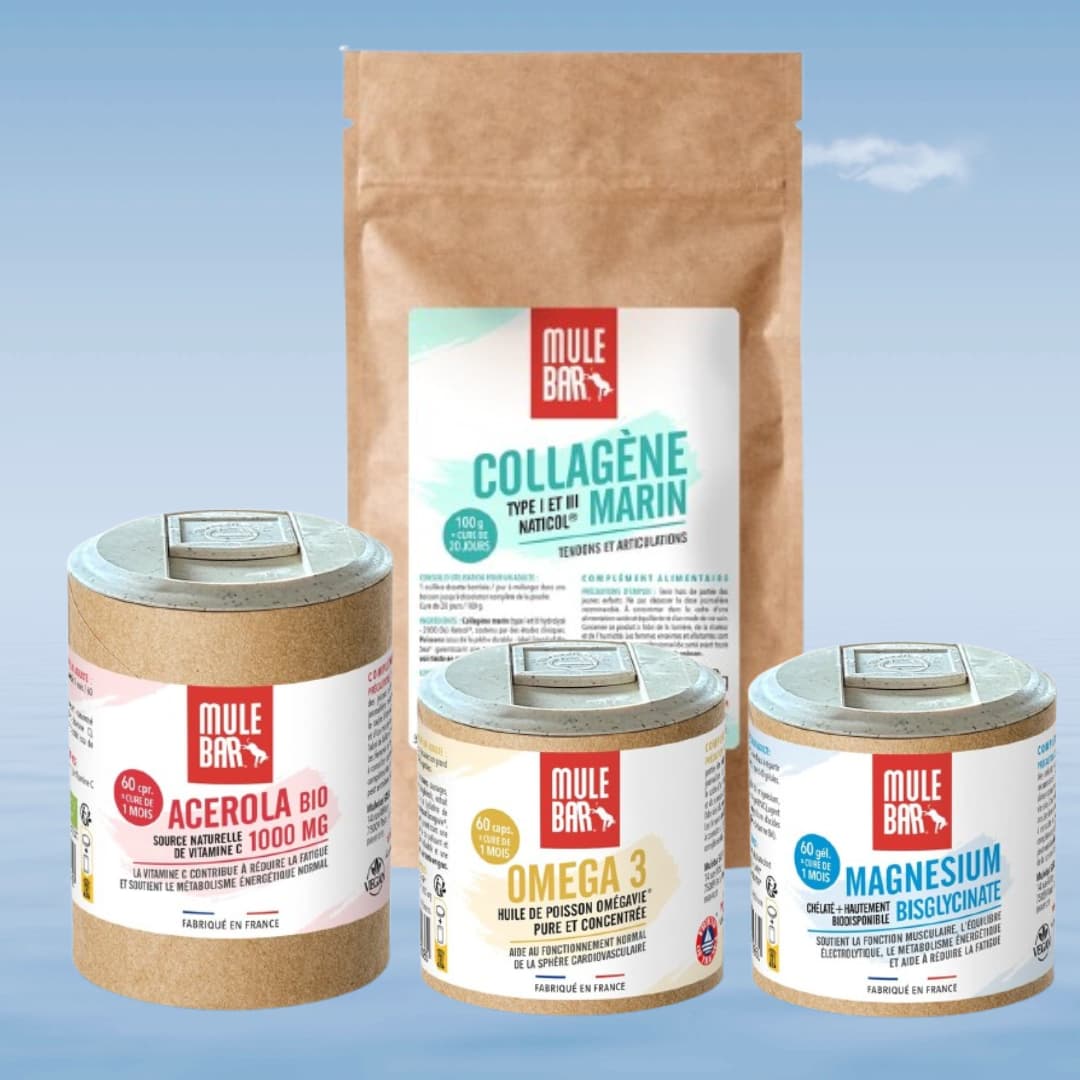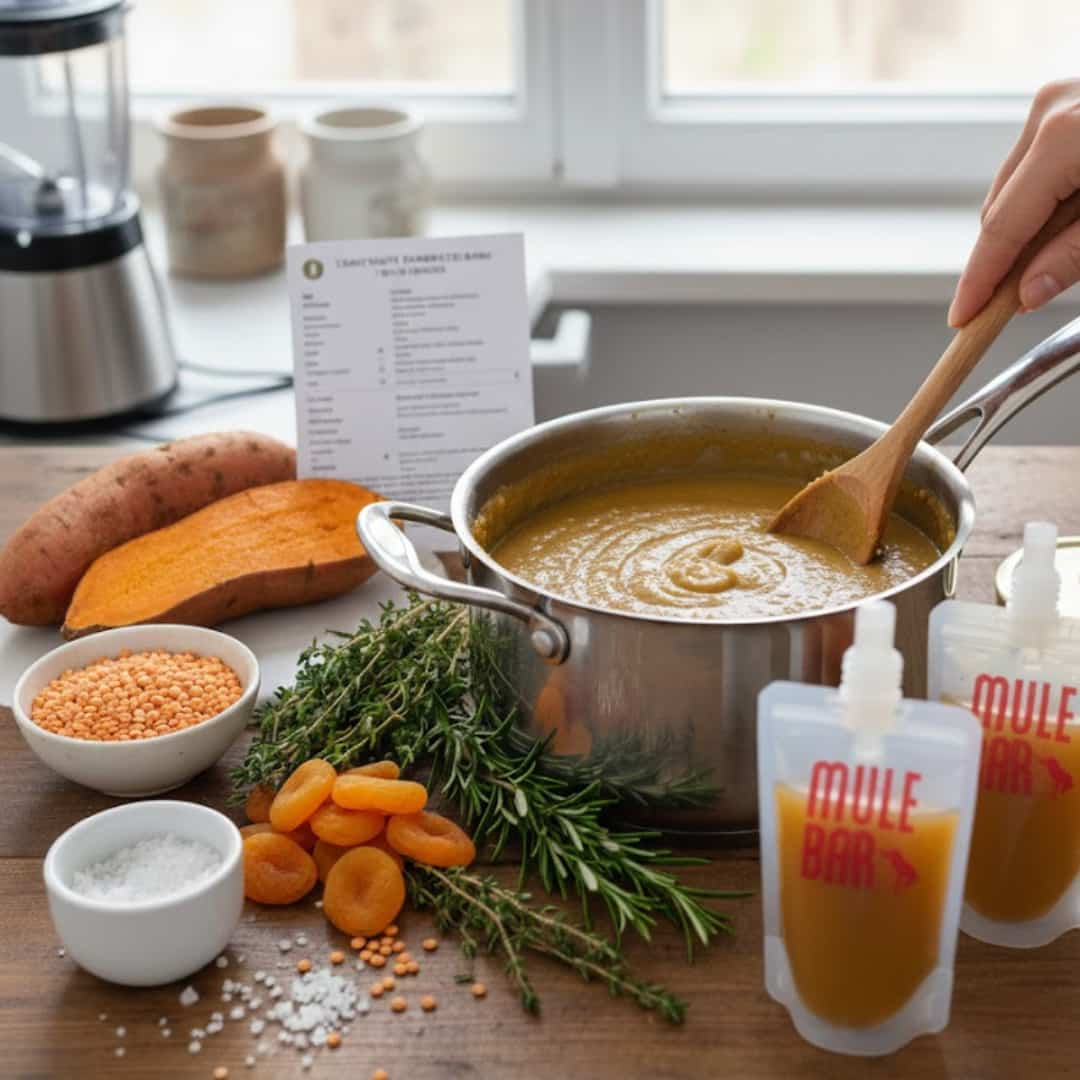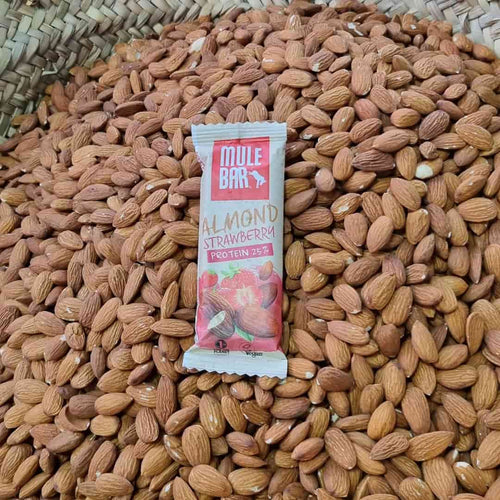Summary
- Salty energy compote for sports
- Homemade Salty Energy Mash Recipe
- Salty energy puree with nutritional benefits
- Use of energy puree in sport
- Ideas for savory energy purees
Mulebar does not offer a savory energy compote in its range. Demand is too low compared to the minimum production quantities required by the manufacturer. While we wait for a more buoyant market and the creation of a savory energy compote, here is a recipe to make yourself at home
Looking for a more natural solution than traditional, overly sweet energy gels for your workouts? This homemade savory energy compote recipe lets you create a customized snack perfectly suited to your endurance needs, while controlling each ingredient according to your preferences and nutritional requirements.
Salty energy compote for sports
Endurance athletes are familiar with the feeling of tiredness and saturation from sweet flavors after several hours of exertion. Salty energy compote then becomes a valuable ally in sports nutrition. This energy puree combines the rapid action of carbohydrates with a satiating texture and a salty touch that stimulates the appetite, even after long hours of physical activity.
Why a salty energy puree?
A homemade savory energy compote consists of a smooth vegetable puree—sometimes enriched with fruit—to which fast-acting carbohydrates and salt (sodium) are added. This tasty blend perfectly meets the athlete's three essential needs: providing immediate energy, compensating for electrolyte losses due to perspiration, and breaking the monotony of sugary foods.
The salty side has clear physiological benefits. It naturally stimulates thirst and promotes water retention, two crucial elements during prolonged exercise. What's more, this flavor, provided by ingredients like miso or concentrated broth, revives taste buds tired from hours of eating sugary foods.
- Sugar control : You choose the type of carbohydrates yourself (brown rice syrup, agave syrup, maltodextrin) and can avoid fructose, which is sometimes poorly tolerated.
- Nourishing texture : Its thicker consistency provides a feeling of satiety superior to classic liquid gels.
- Natural Ingredients : Minimally processed vegetables, spices and herbs with no artificial additives.
- Practical packaging : Use of reusable water bottles with caps, more environmentally friendly than disposable plastic packaging.
This product is particularly aimed at endurance sports enthusiasts: cyclists, trail runners, marathon runners, triathletes, etc. These disciplines require a regular intake of carbohydrates over long periods, where the variety of flavors becomes a real asset for performance.
Differences with a liquid gel
The main difference between energy compotes and energy gels lies in their composition and texture. The gel is a concentrated syrup composed primarily of carbohydrates, designed for ultra-fast absorption. Its liquid texture also allows for easy dilution to prepare energy drinks.
The compote offers a thicker texture, close to a smooth purée. This increased nutritional density ensures longer-lasting satiety and gives the impression of consuming "real" food, particularly appreciated during prolonged efforts. Our 100% natural Mulebar energy compotes, made in Ardèche, contain at least 45% fruit and represent a delicious alternative to traditional gels. Learning more about these natural energy compotes will allow you to compare these ready-to-use products with a homemade savory version adapted to your specific needs.
When should you eat a salty energy compote?
The instructions for using a savory energy puree follow the same principles as for sweet gels or compotes. Consume it shortly before a demanding portion (climbing, acceleration) and then at regular intervals during exercise. The main difference lies in the distribution of the doses.
A 65-gram pouch is ideally consumed in small amounts every 15 minutes, rather than all at once. This method promotes better digestion while maintaining a consistent energy intake. For efforts exceeding two hours, plan on approximately one pouch per hour, possibly alternating with other sources of carbohydrates.
Always remember to accompany each intake with a few sips of water or a very low-sugar hydration drink. This habit improves digestive comfort, optimizes nutrient assimilation and maintains good oral hygiene during exercise.
Homemade Salty Energy Mash Recipe
This easy sweet potato recipe makes six generous portions (300-350g each), perfect for your workouts. Its velvety texture and balanced flavor make it easy to eat during exercise, without the need for chewing.
Ingredients and proportions
To make your own savory energy compote , here are the quantities tested and approved by many athletes. The ingredients have been chosen for their digestibility and their nutritional intake adapted to prolonged exercise.
- Main base : 1 kg of sweet potato - a tuber rich in slow-assimilation starch, comparable to a natural maltodextrin
- Liquids : 500 ml of natural soy milk + 200 ml of vegetable cream to obtain a smooth texture
- Adjustment : 200 ml of water for a thick puree or 400-500 ml for a thinner version
Spices are essential for taste and benefits: 3 teaspoons of turmeric (anti-inflammatory), 3 teaspoons of ginger (aids digestion), 3 teaspoons of spirulina (protein supply) and 12 pinches of fleur de sel to rebalance electrolytes lost during sport.
Preparation and liquid texture
How you prepare your savory compote determines its final texture. Start by peeling and cutting the sweet potatoes into evenly sized pieces for even cooking.
Boil the plant-based milk with the water, add the potato pieces, and let them cook gently for 30 minutes until tender. Then blend with the plant-based cream and all the spices until you get a perfectly smooth energy puree . The amount of liquid added makes all the difference: 200 ml for a thick compote (ideal for rigid jars) or 400-500 ml for a thinner texture (perfect for soft pouches).
Packaging and storage
Transfer your still-hot savory energy puree into sterilized containers (water bottles, flasks, or jars). Hot filling improves shelf life by eliminating bacteria.
Let cool to room temperature before refrigerating. Your homemade savory energy compote will keep for 5 to 7 days at temperatures below 6°C. You can also freeze it (1 to 3 months), leaving 1-2 cm of air in the container for expansion.
Tip : Remember to label your preparations with the date and composition for optimal use.
In conclusion, this savory compote recipe is a real nutritional ally for athletes, easy to prepare and personalize according to your needs and tastes.
Salty energy puree with nutritional benefits
This analysis reveals that salty energy puree is a food perfectly suited to endurance sports .
A 300 to 350 gram serving provides a balanced supply of essential nutrients, providing both energy and the elements needed to perform.

Nutritional Information
Prepared at home, a portion of salty energy compote contains approximately 195 kcal, with an optimal balance:
- 22.6g of carbohydrates (including 11.1g of fast sugars)
- 7.3g of vegetable protein
- 7g of fat
This composition ensures a progressive release of energy , perfect for supporting prolonged effort .
With 468mg of salt per serving, this energy puree effectively compensates for losses due to perspiration.
| Nutrient | Quantity for 350g | % NRV |
| Energy | 195 kcal | 10% |
| Carbohydrates | 22.6 g | 9% |
| Proteins | 7.3 g | 15% |
| Lipids | 7 g | 10% |
| Sodium | 468 mg | 20% |
| Magnesium | 67 mg | 16% |
How to enrich without digestive discomfort
To personalize your homemade salty energy compote according to the principles of sports nutrition , here are some effective tips:
- Carbohydrate boost : maltodextrin (10-20g), agave syrup or brown rice syrup for gradual energy.
- Lipid intake : add 1 tablespoon of olive oil for very long efforts.
- Proteins : can be enriched with BCAA powder.
- Electrolytes : citrates recommended in case of heavy sweating.
Be careful with concentrates, moderate the doses (4 drops of essential oils max for 6 servings). Guarana can provide a useful boost for nighttime efforts.
This homemade salty energy puree thus becomes a tailor-made ally for your sports practice.
Use of energy puree in sport
The success of an energy puree during a sporting activity depends mainly on three factors: its texture, its packaging, and the way it is ingested. These technical elements directly influence the ease of use and digestion during exercise.
Transport textures and formats
The texture determines the best way to transport your homemade savory energy drink. A thinner recipe (with 400 to 500 ml of water) pours easily from soft drinks or flasks, allowing for effortless one-handed consumption.
Conversely, a thicker preparation (only 200 ml of water) is better suited to rigid containers or doypack pouches that require squeezing. This compact energy puree also provides a longer-lasting feeling of satiety, particularly useful for prolonged efforts.
For transport, choose containers adapted to your discipline: soft water bottles in cycling pockets, small 80-100g sachets for running, or bottles attached to the frame for cycling. Remember to label your preparations clearly so you can quickly identify them during exercise.
Dosage during exercise
Optimal carbohydrate intake varies between 50 and 120g per hour depending on intensity, weight, and individual tolerance. A serving of trail energy compote (80-100g) provides approximately 25-35g of carbohydrates, which requires 1 to 3 hourly intakes.
- Splitting up your intake : Small amounts every 20-30 minutes rather than a single large portion.
- Adaptation to effort : Increase frequency during intense phases or in hot weather.
- Combined hydration : Always accompany with water or a hydration drink for better assimilation.
- Anticipation of efforts : Consume a few minutes before planned climbs or accelerations.
Your digestive tolerance takes precedence over theoretical recommendations. Some athletes prefer to take more spaced out but consistent doses, while others prefer small, very regular doses. Only training can validate your personal strategy before major competitions.
Hydration and warmth
Environmental conditions significantly alter water and electrolyte needs. In hot weather, slightly increase the salt content of your recipe (an additional 1/4 teaspoon) to compensate for sweat loss.
Hydration then becomes critical: each intake of salty energy compote should be followed by 150-200 ml of water, preferably fresh, to ensure good digestion and maintain fluid balance. For long rides, you can enrich this water with electrolytes.
Be alert to signs of dehydration: dry mouth, less frequent urination or digestive discomfort should alert you and require immediate adjustment of your fluid intake.
Ideas for savory energy purees
Thanks to the variety of vegetables and herbs, you can create savory energy purees with a variety of flavors, perfect for avoiding monotony during your repeated workouts.
All these versions maintain the same nutritional benefits while offering pleasant taste differences.
Quick recipes and variations
Beyond the basic recipe, several adaptations allow you to personalize your homemade savory energy puree according to the vegetables available and your preferences.
The carrot-sweet potato version combines 150g of carrots, 100g of sweet potato, 100g of potato and 100g of white onion, all blended with 50g of oat powder.
- Curry-paprika version : 1 kg of potatoes, vegetable milk, oat powder and a mixture of spices (curry, paprika, spirulina).
- Express preparation : 400g sweet potato, 120g carrot, 60g fruit compote, 1 teaspoon miso and a drizzle of olive oil.
- Umami Option : The usual vegetable base enriched with concentrated broth or miso paste to enhance the salty taste.
There are plenty of alternatives: pumpkin or beetroot to diversify the colors and nutrients; almond puree or tahini for good fats; and a little guarana powder provides a natural boost during prolonged exercise .
Cooking, texture and tolerance
The type of cooking directly influences the digestibility of your recipes.
Steaming preserves vitamins and minerals better, while pressure cooking speeds up the preparation without sacrificing too much nutritional qualities.
For better digestion, blend your vegetables while still warm and refrigerate them quickly.
This technique reduces the risk of fermentation and prolongs conservation.
If you experience digestive discomfort during the tests, gradually reduce the fiber by peeling the vegetables well and possibly filtering the puree .
Add spices like cumin, paprika, or thyme in small amounts at first to get your body used to them before increasing the doses.






Leave a comment
This site is protected by hCaptcha and the hCaptcha Privacy Policy and Terms of Service apply.